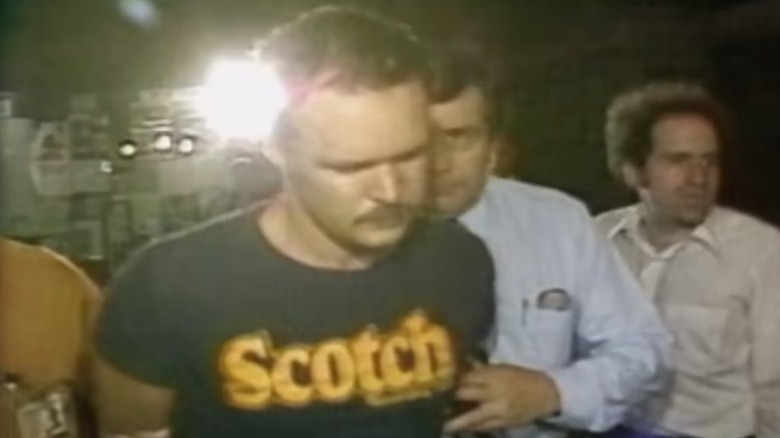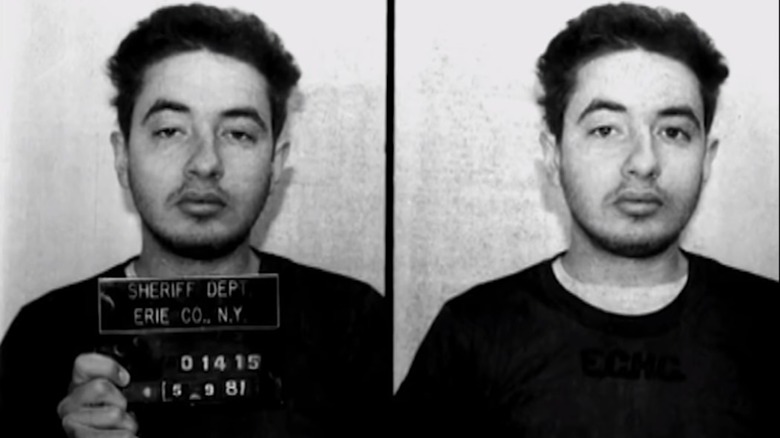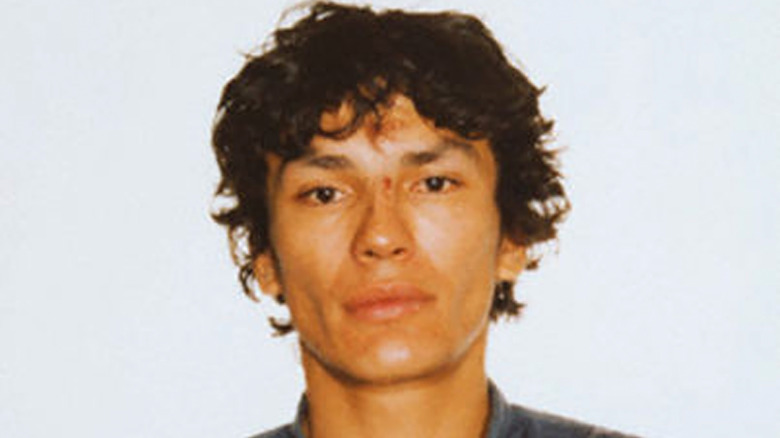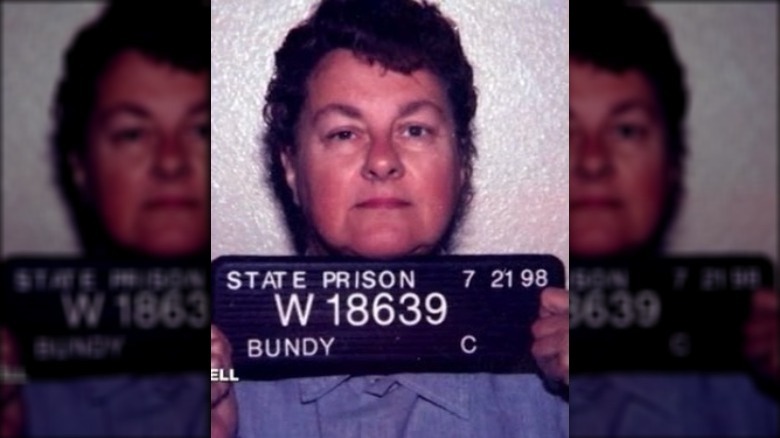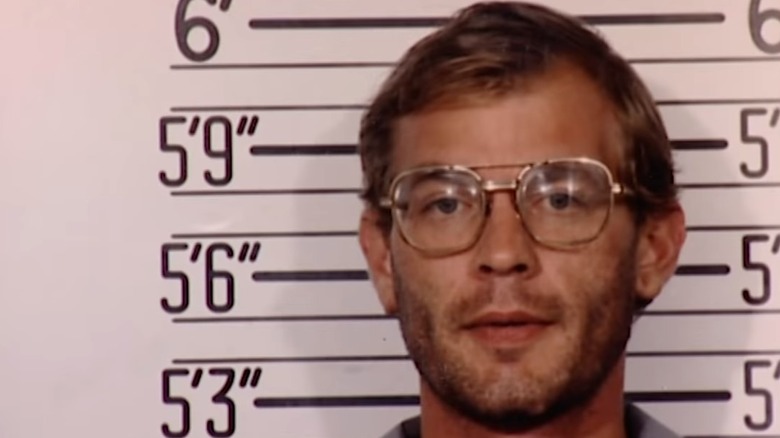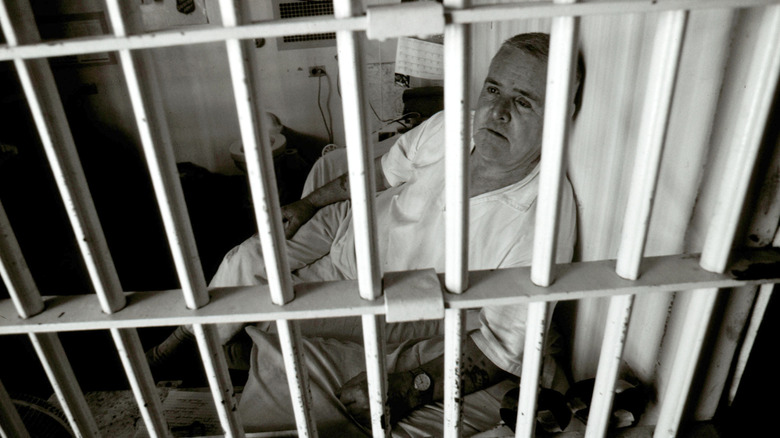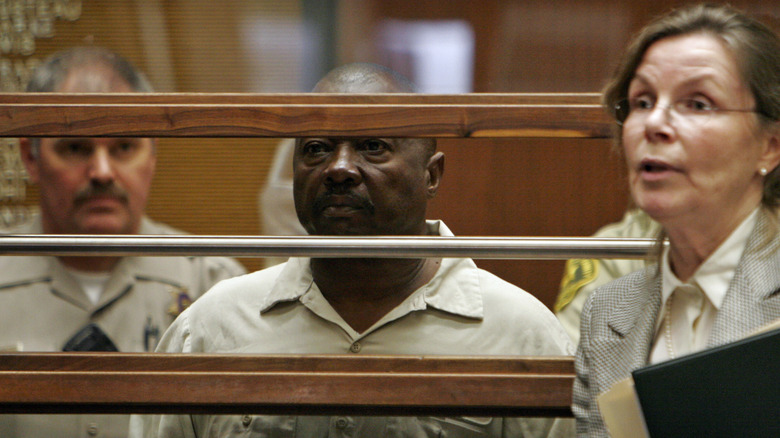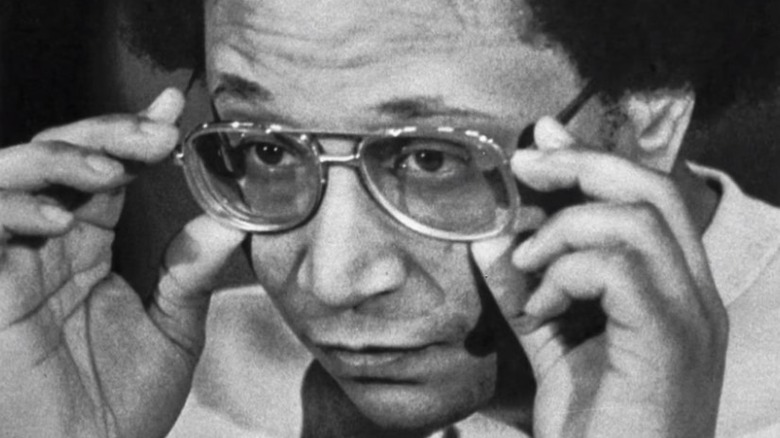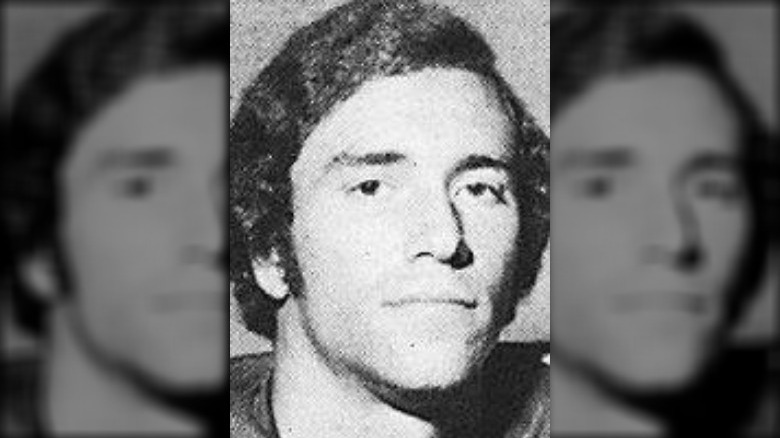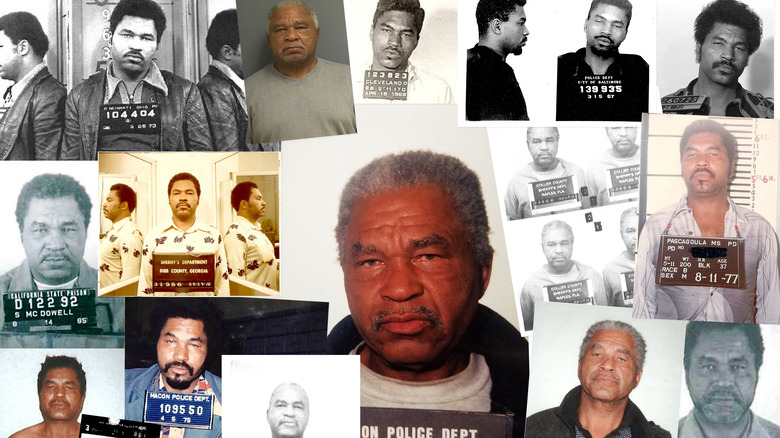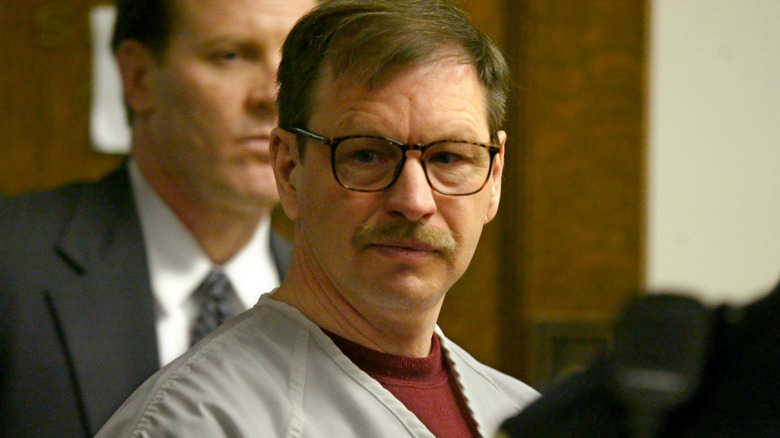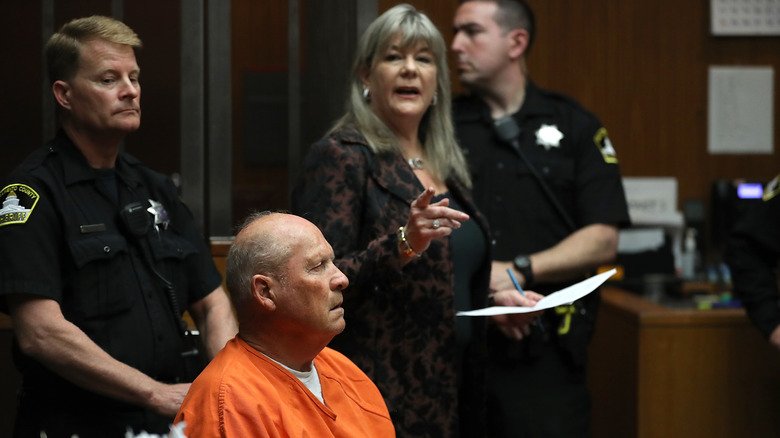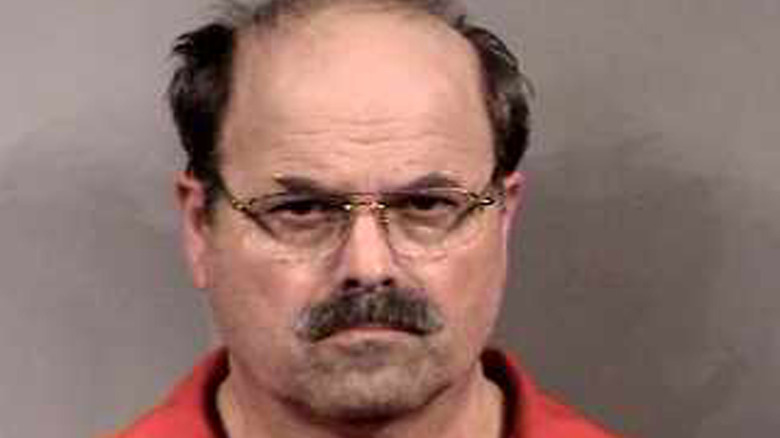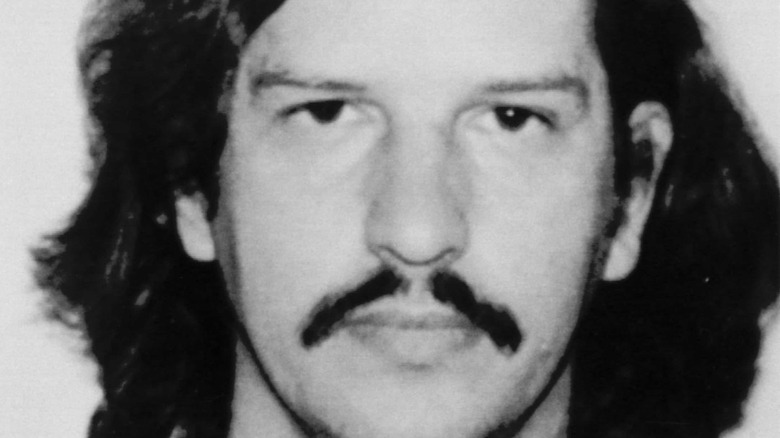16 Of The Most Dangerous Serial Killers Of The 1980s
If movies set in the 1980s have taught us anything, it's that everyone had wild hair and wore mom jeans. Also, there were serial killers around every corner. Modern films set in the '80s involving serial killers or other criminals are not in short supply today. Heck, even movies made in the '80s often featured serial killers who were unstoppable and endlessly bloodthirsty.
And people were rightfully afraid of that. In recent years, data has shown that serial killers peaked in the '80s, as per BBC. For some reason, it was a very popular way to kill people for many years, and then in the '90s and 2000s it sort of petered out.
But the 1980s didn't just boast the highest concentration of serial killers — it also featured some of the deadliest, and a lot of them may be people whose names you don't even know.
Larry Eyler, the Highway Killer
Larry Eyler may not be a household name, but he was one of the deadliest serial killers around. Between 1982 and 1984 in Illinois and Indiana, Eyler is known to have killed at least 21 young men and boys. That's not the whole story, though. What's remarkable is that he was caught and released twice.
In 1978, Eyler offered a ride to a hitchhiker, Craig Long. Eyler propositioned Long sexually, which Long declined. This caused Eyler to become violent. He stabbed Long and left him by the roadside, thinking him dead. Long crawled away and contacted the police. Eyler then returned to the scene, telling police the stabbing was accidental. They found numerous weapons and handcuffs in Eyler's backseat, but he was released after his housemate offered Long $2,500 to drop the charges, according to All That's Interesting.
Eyler was then arrested for solicitation in 1983. Police found weapons and handcuffs in his vehicle once again and notified a task force hunting the "Highway Killer." Authorities checked into Eyler and searched places where Eyler was known to reside. They found enough evidence to arrest him for murder, but the searches were deemed illegal. Eyler's housemate then paid his bail. Eyler was released, and he committed one final murder, which ultimately led to his conviction.
Joseph Christopher, the .22 Caliber Killer
Better known as the .22 Caliber Killer, Joseph Christopher murdered at least a dozen people, mostly Black men and boys, between 1980 and 1981. His first four slayings took place over a two-day period, and these were actually the only murders where he used a .22 caliber weapon, after which he switched to stabbing or bludgeoning victims, according to The Buffalo News.
What's especially odd is that Christopher had newly joined the army during his killing spree, notes History. And it was while in the military that Christopher was caught. He attacked a fellow soldier (who was also Black), which led to him talking to an Army nurse during his care, to whom he confessed. Christopher was virulently racist, telling the nurse he "had to" kill Black people, as per The New York Times. He was quickly turned over to police, and Christopher was convicted of three of the murders but admitted to many more.
Christopher had actually been diagnosed with paranoid schizophrenia before his killing spree, as per the Buffalo and Erie Country Public Library. He tried to admit himself to a psychiatric hospital earlier in 1980 but was turned away because he didn't seem dangerous at that time. Fourteen days after he was denied, he killed his first victim.
Richard Ramirez, the Night Stalker
When most folks think of '80s serial killers, Richard Ramirez is probably who they think of first. Even before characters based on him appeared on "American Horror Story," Richard Ramirez was a popular guy. During his trial and subsequent incarceration, he gained a ton of fans and devotees, with reports stating that he received hundreds of love letters during his incarceration (via Esquire).
Richard Ramirez killed at least 14 people between 1984 and 1985, according to Biography. Many of the murder scenes had Satanic imagery, and he claimed to be a practicing Satanist. Richard had a very traumatic childhood. He suffered from a head injury at the age of 5 that left him epileptic, his father was abusive, and his cousin Miguel Ramirez regaled Richard with stories about his time in Vietnam, namely about torturing and abusing civilian women. These stories came alongside graphic, gory photos Miguel had taken while committing the acts he described. Richard was even present on the day when Miguel and his wife had an argument that led to Miguel murdering her in front of Richard's eyes.
And just as outlandish as Richard's personality is the story of his capture. He left a fingerprint at a crime scene in late August of 1985, so police finally identified him as the Night Stalker and began publicly running his picture in the press. On August 31, Richard Ramirez was recognized attempting to break into a car and chased down and beaten by an angry mob in broad daylight.
The Sunset Strip Killer(s)
In early 1980, after several murders on the Sunset Strip in West Hollywood, police declared the deaths to be the work of a serial killer, whom the press quickly dubbed the Sunset Strip Killer. The police and the media had it wrong, though. There wasn't just one Sunset Strip Killer, but two.
Doug Clark was a con-man who had a history of talking his way into the homes of older women so that he had a place to stay, according to L.A. Magazine. This was probably what he had in mind when he met a nurse named Carol Bundy. Soon, though, Clark was talking her into far more than that. He convinced Bundy to lure an 11-year-old residing in Bundy's apartment building into a sexually abusive relationship with him. Sadly, that was only the beginning.
Soon, Clark started talking about his violent sexual fantasies. Amazingly, she agreed to assist him. The pair killed and mutilated at least six before Bundy got a guilty conscience. She confessed to an ex-boyfriend but, fearing he might turn her in, killed him immediately afterward. Before long, though, Bundy was telling her co-workers that she couldn't reconcile the murders with her job as a nurse, where she was meant to save lives. Her stunned colleagues turned her (and Clark) in, but lest you think that she was a victim, it's worth noting that Bundy admitted to the cops that she willingly participated in the slayings.
Jeffrey Dahmer
While the Milwaukee Cannibal, Jeffrey Dahmer, is most frequently associated with the 1990s, when many of his crimes occurred and when he was caught, Dahmer was active in the 1980s as well. His first victim was actually in 1978, and while he wasn't as prolific until 1990 and 1991, he definitely qualified as dangerous.
Dahmer was notorious for his brutal murders, mutilating the bodies of his victims and consuming flesh and organs left behind after he was done. Earlier in his history, the cannibalism hadn't really ramped up yet, however, so several of his murders from the 1980s ended up as trophies the police would eventually find when he was caught.
Speaking of his capture, it's an oddly anti-climactic one. Police found a man named Tracy Edwards wandering the street with handcuffs around one wrist, according to Biography. Edwards told them about a strange man who drugged and restrained him, but he had managed to escape. Edwards told them exactly where Dahmer lived, and upon investigating his apartment, found heads in his refrigerator and freezer, among various other body parts. What really did him in, though, were the extremely graphic Polaroid photos he had taken of himself killing and dismembering people. Turns out, that's really good evidence in court. Dahmer murdered about 17 young men then was murdered himself in prison in 1994.
Henry Lee Lucas and Ottis Toole, the Confession Killers
Two of the 1980s' deadliest serial killers actually teamed up and committed a bunch of murders as a duo. Henry Lee Lucas and Ottis Toole met at a soup kitchen in 1976 where they quickly began a relationship. Lucas and Toole had both already committed murders on their own at this point, and things only escalated from there. They continued murdering, and committing various other crimes, together until 1983, at which point they went their separate ways but still kept killing people, according to All That's Interesting.
What caused the split? Lucas became obsessed with Toole's niece, Becky Powell. She was a minor, at only 15 years of age, as per Newsweek, but serial killers aren't exactly known for following the law. Lucas and Powell started a relationship, but things didn't go so well — he ended up murdering her, too. Lucas was caught in 1983, and Toole followed in 1984.
It's not even clear how many they killed, together or separately, because both of the men were compulsive liars. They discovered that they could get special treatment in prison by confessing to every murder police asked them about, and to make things worse, they would back up one another's stories as well, even if facts showed that they couldn't have committed the crimes. Lucas claimed to have killed 600 people, and Toole claimed 100 victims, but neither of these numbers are considered very likely.
The Connecticut River Valley Killer
One serial killer who terrorized New England between 1978 and 1988 remains unknown — they were never caught. Stalking the border between Vermont and New Hampshire, the Connecticut River Valley Killer committed a series of stabbings that left at least seven dead, according to true crime writer Lisa Marie Fuqua.
In fact, it seems that the primary reason the killer ended their spree was because they were very nearly caught. In 1988, the killer attacked a woman named Jane Boroski, who stopped to get a drink out of a roadside vending machine. While the murderer stabbed Boroski 27 times and left her for dead, Boroski, seven months pregnant, managed to crawl back to her car and drive to a friend's house. On the way, she realized that the vehicle in front of her was the killer, but they drove off before anyone could apprehend them. When she reached her friend's house, the residents called paramedics. Boroski survived, as did her baby.
Boroski assisted the authorities with as much information as she could manage, but they ended up never having enough to arrest anyone. While a few people have emerged as potential suspects, none were ever arrested or convicted for the crimes. After Boroski got away, though, what she shared with police must have spooked the killer — the Connecticut River Valley Killer disappeared after that.
Lonnie David Franklin Jr., the Grim Sleeper
Lonnie David Franklin Jr. has an odd nickname for a serial killer — the Grim Sleeper. Franklin got the nickname because he committed a spree of murders in the 1980s, up until 1988, and then "slept" for 14 years, meaning he didn't kill again until 2002, according to Rolling Stone.
It wasn't initially clear that his crimes were the work of a serial killer. He operated in the Los Angeles area, but there were a number of serial killers terrorizing the same area at the same time and killing the same sorts of victims — Black sex workers. Police were so overwhelmed, they couldn't tell one murderer from another, so Franklin's killings simply blended in.
In 2002, the murders began again. Investigators theorized that these new killings were the work of a serial killer and possibly connected to murders committed 20 years before. It wasn't until 2007 that the theory was confirmed. Franklin left DNA at a fresh crime scene, which linked him to at least 11 unsolved murders from the 1980s. In 2010, they finally matched Franklin's DNA to that of his son, Christopher, who had been arrested on a weapons charge in 2008. It's also worth noting that it's not for certain that Franklin was dormant during the entire 14 year period. Authorities say it's possible Franklin committed at least some murders during that time.
The Atlanta Monster
Between 1979 and 1981, a monster was terrorizing Atlanta. During this span, around 30 children, almost all young Black boys, turned up dead. The choice of victims and the brutality and relentlessness of the killings began to inflame racial anger in Atlanta. Rumors spread widely that the Atlanta Child Murders weren't committed by a single serial killer but multiple members of the Ku Klux Klan.
Authorities set up task forces and made numerous attempts to track down the killer, but to no avail. Finally, they decided to stake out a bridge that the killer had used as a dump site more than once, according to Women's Health. One night, police heard a loud splash, as if someone dropped something into the water. They quickly pulled over a driver named Wayne Williams and arrested him. It soon became clear that they had caught him disposing of the body of a man named Nathaniel Cater.
This was only part of the story, however. Soon, investigators found carpet fibers in Williams' car, his house, and on his person consistent with similar fibers found on most of the Atlanta Child Murder victims. In particular, they noted the presence of green fibers that matched the carpet in Williams' house (via Oxygen). Williams was tried and sentenced to life for the murder of Cater and another adult, Jimmy Ray Payne. He has never been tried for the Atlanta Child Murders, but the killings stopped after he was caught.
Randall Woodfield, the I-5 Killer
Between 1980 and 1981, Interstate 5 was the stalking ground for a murderer dubbed the I-5 Killer, who sexually assaulted his victims before killing them. Police quickly came to suspect Randall Woodfield, who had previously been arrested for indecent exposure and second-degree robbery due to a string of thefts where he also assaulted victims, according to Sports Illustrated.
Two of the earliest victims were women Woodfield knew, but police didn't have enough evidence to convict him. Before long, though, Woodfield lost control and became less cautious while committing more and more offenses, from murder to petty robbery. He was positively identified by survivors of his attacks, which led to his arrest and conviction. While he was only convicted of a single murder and an attempted murder of another woman, DNA evidence has linked Woodfield to at least a dozen of the crimes, and it's possible he was involved in up to 44.
One thing that particularly stood out about Woodfield, and was unusual for a serial killer, was his day job — Woodfield was a professional football player and was even drafted by the Green Bay Packers in 1974, though he never made it onto the field during the season. The team cut him during training. While the team officially cut him for performance reasons, it is rumored that they found out about his numerous arrests for indecent exposure and kicked him out as a result.
Samuel Little
On the surface, Samuel Little didn't seem particularly dangerous. In 2014, after an arrest for a drugs charge, authorities tested Little's DNA and found a match to three murders committed in 1987 and 1989. Little was convicted of the murders and sat in jail for four years before he claimed responsibility for over 90 killings, according to NPR.
It's not unusual for serial killers to inflate their murder counts, but Little's case was different because of the sheer detail of information he gave to police. Little died in 2020, but as of 2021, the FBI has confirmed that Little was involved in at least 50 of the 90-plus murders. This has already propelled him to the top of the list of most prolific serial killers, and investigations into the remaining 40-plus cases are ongoing.
Little not only remembered where he committed his various murders, he even remembered many of their names and faces. He sketched portraits of his victims and often had unreleased details of the crimes, such as positions in which bodies were found. The evidence Little provided authorities is chilling in terms of scope and magnitude. Most disturbing of all is that he was able to kill for decades without arousing any suspicion. Before his confessions, no one even suspected these crimes were the work of a serial killer.
Gary Ridgway, the Green River Killer
Throughout the '80s and '90s, the Green River Killer stalked Washington state, killing seven people, or so police thought. In 1987, they thought they found their man, Gary Ridgway, according to Thought Catalog. They didn't have enough evidence to convict him, but the police did something that would later turn out to be crucial in the case — they took samples of Ridgway's hair.
The Green River Killer case sat untouched for years until new DNA technology in 2001 triggered a re-examination of evidence in unsolved cases. Nearly 15 years later, DNA testing had advanced to such a state that those 1987 samples of Ridgway's hair could finally be definitively linked to the Green River killings. Police arrested Ridgway as he was leaving the factory where he worked.
While Ridgway was only suspected of those original seven killings, he struck a deal with prosecutors. He agreed to give details of other murders he had committed and plead guilty to each in exchange for life in prison, as opposed to the death penalty. He ended up confessing to over 70 murders. Nearly 50 of those were confirmed by authorities, making Ridgway one of the most prolific serial killers ever and, serving 49 life sentences along with an additional sentence of 480 years for evidence tampering, also one of the longest sentenced criminals in United States history.
Joseph DeAngelo, the Golden State Killer
Arguably one of the most terrifying aspects of the horrific crimes committed by Joseph DeAngelo, known as the Golden State Killer, was the fact that he almost got away with it. The ex-cop's spree of murders began in 1975 when he shot professor Claude Snelling to death, and then continued well into the following decade with the assault and killing of his last known victim, Janelle Cruz, in 1986, according to ABC News. Throughout those terrifying years, DeAngelo ended the lives of 13 victims before his case went cold due to a lack of substantial evidence linking him to the crimes.
For over 30 years it appeared like the family members of DeAngelo's victims would never get justice for the slaying of their loved ones until a breakthrough was made in 2018. Investigators were able to use public genealogy databases to make a solid connection between DNA collected at the crime scene decades before together with samples from the killer's family members. Law enforcement officers were then able to narrow their search to DeAngelo and confirm the match from his DNA on a tissue that he placed in the trash.
With the evidence stacked against him, the Golden State Killer plead guilty not only for the heinous murders but also a number of other brutal assaults. It may have taken many years, but at least the dangerous criminal is finally behind bars where he belongs and will remain there from now on.
Dennis Rader, the BTK Killer
What made Dennis Rader both extremely dangerous and terrifying was his ability to evade law enforcement over a long span of three decades. Biography provides the absolutely chilling detail that he blended into society with ease with a family, an average government job, and as an avid church goer. But his dark side was extremely brutal and led to the deaths of 10 victims, whose lives he took with no remorse as he gave himself the horrid moniker, the BTK Killer, for "bind, torture, kill."
Throughout the 1970s, '80s, and up until 1991, Rader carried out the murders without any chance of getting caught. However, the BTK Killer caused his own downfall because he could not let the authorities and the public think that he was either dead or caught. According to Britannica, when a newspaper speculated these possibilities, he had to draw attention back to himself. Yet, when he went so far as to anonymously reach out to the police and ask if they could trace a floppy disk back to him, law enforcement seized the opportunity by lying to him.
Once the authorities told Rader that it could not be linked to him, he sent the disk, and investigators managed to link his DNA to a sample collected at one of the crimes scenes. After confessing to the murders and showing disbelief that the police deceived him, his sentence was 10 consecutive life terms.
The Ripper Crew
In the early 1980s, the satanic cult called the Ripper Crew was exceptionally dangerous because it was group of four men who planned and carried out their brutal murders together in a very short amount of time. From spring 1981 to fall 1982, it is estimated that the vile gang terrorized as many as 20 women with torture first before causing their brutal deaths using blunt objects, hatchets, or other bladed weapons, says A&E True Crime.
The Ripper Crew, comprised of Robin Gecht and Edward Spreitzer, along with the brothers Andrew and Thomas Kokoraleis, was finally stopped in October. After a victim survived their vicious assault and went to the police, her account combined with those of other witnesses provided what investigators needed to find the perpetrators and bring them into custody. Even though the brothers and Spreitzer confessed to killing multiple women, and claimed the crimes were committed while using drugs and alcohol, investigators were unable to confirm the exact number of victims.
Andrew was executed in 1999 for murder, while Spreitzer and Gecht both received long sentences and remain behind bars, with the former serving a life term. Thomas, on the other hand, was set free in 2019 after serving just half of his 70-year sentence. The remaining Kokoraleis brother then went to live at a Christian shelter for ex-convicts.
William Bonin, the Freeway Killer
William Bonin was another one of the most dangerous serial killers of the early 1980s because of the rapidity to which he carried out his ghastly crimes. It began in 1975 when he was caught and imprisoned for sexually assaulting a minor. Bonin served three years behind bars, but before his incarceration, he made the absolutely chilling statement to an officer that the next time he would not leave a living victim, according to the Los Angeles Times. So, once he was released in 1978, the murderer followed through with his claim and began a killing spree of 21 men and boys.
Bonin was even more lethal due to the fact that he had accomplices, yet those same people turned on him after he was arrested again in June 1980 for assault. Their testimony, along with evidence like the wire and rope found in Bonin's van, led to a conviction and death sentence for the heinous nature of his crimes.

